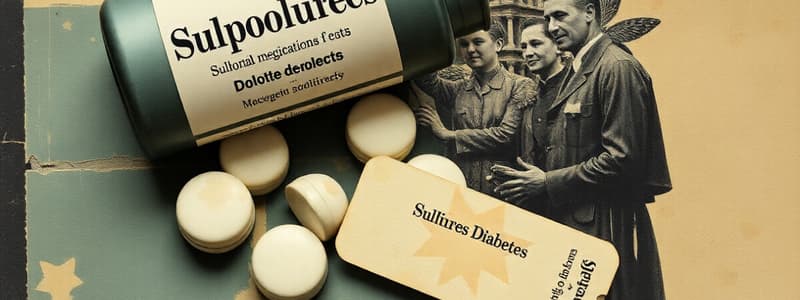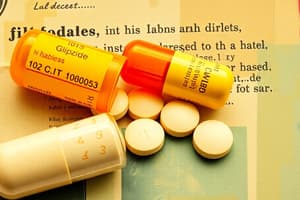Podcast
Questions and Answers
A client with type 2 diabetes is prescribed a sulfonylurea medication. What is the primary mechanism of action of this drug class in managing hyperglycemia?
A client with type 2 diabetes is prescribed a sulfonylurea medication. What is the primary mechanism of action of this drug class in managing hyperglycemia?
- Inhibiting glucose absorption in the intestines.
- Decreasing glucose production by the liver.
- Stimulating the beta cells of the pancreas to release more insulin. (correct)
- Increasing the sensitivity of peripheral tissues to insulin.
A nurse is educating a client who is newly prescribed glyburide for type 2 diabetes. Which instruction is most important for the nurse to include regarding medication administration?
A nurse is educating a client who is newly prescribed glyburide for type 2 diabetes. Which instruction is most important for the nurse to include regarding medication administration?
- Administer the medication at bedtime to optimize overnight glucose control.
- Take the medication with food to minimize the risk of hypoglycemia. (correct)
- Take the medication on an empty stomach to enhance absorption.
- Crush or chew the medication for faster onset of action.
A client taking glimepiride reports experiencing frequent episodes of hypoglycemia. Which of the following lifestyle adjustments should the nurse recommend to help prevent these episodes?
A client taking glimepiride reports experiencing frequent episodes of hypoglycemia. Which of the following lifestyle adjustments should the nurse recommend to help prevent these episodes?
- Maintain a consistent carbohydrate intake and avoid skipping meals. (correct)
- Reduce physical activity to decrease glucose utilization.
- Take the medication at varying times each day to prevent tolerance.
- Increase alcohol intake to improve glucose metabolism.
Which of the following adverse effects is most closely associated with sulfonylurea medications such as glipizide?
Which of the following adverse effects is most closely associated with sulfonylurea medications such as glipizide?
A client with type 2 diabetes who is allergic to sulfa drugs is prescribed an oral antidiabetic medication. Which of the following medications should the nurse question?
A client with type 2 diabetes who is allergic to sulfa drugs is prescribed an oral antidiabetic medication. Which of the following medications should the nurse question?
What is the primary action of Metformin in the management of type 2 diabetes?
What is the primary action of Metformin in the management of type 2 diabetes?
Which of the following adverse effects is a potentially life-threatening complication associated with metformin use?
Which of the following adverse effects is a potentially life-threatening complication associated with metformin use?
A client taking metformin experiences nausea, vomiting, and diarrhea. Which of the following nursing interventions is most appropriate to manage these side effects?
A client taking metformin experiences nausea, vomiting, and diarrhea. Which of the following nursing interventions is most appropriate to manage these side effects?
A patient with renal insufficiency is prescribed metformin. Which consideration is most important regarding their treatment?
A patient with renal insufficiency is prescribed metformin. Which consideration is most important regarding their treatment?
Why is weight gain not typically associated with metformin use?
Why is weight gain not typically associated with metformin use?
A patient taking metformin is scheduled for a CT scan with iodinated contrast. What instructions should the nurse provide?
A patient taking metformin is scheduled for a CT scan with iodinated contrast. What instructions should the nurse provide?
What is the primary mechanism of action of dipeptidyl peptidase-4 (DPP-4) inhibitors?
What is the primary mechanism of action of dipeptidyl peptidase-4 (DPP-4) inhibitors?
A patient on a '-gliptin' medication reports persistent, severe abdominal pain. What is the most appropriate nursing action?
A patient on a '-gliptin' medication reports persistent, severe abdominal pain. What is the most appropriate nursing action?
A patient taking a DPP-4 inhibitor develops a new, itchy rash with large blisters. Which adverse effect is most likely?
A patient taking a DPP-4 inhibitor develops a new, itchy rash with large blisters. Which adverse effect is most likely?
A patient with risk factors for pancreatitis is prescribed a DPP-4 inhibitor. Which of the following considerations is most crucial?
A patient with risk factors for pancreatitis is prescribed a DPP-4 inhibitor. Which of the following considerations is most crucial?
What is the primary goal of exogenous insulin therapy in managing diabetes?
What is the primary goal of exogenous insulin therapy in managing diabetes?
Flashcards
Metabolic Acidosis (from Lactate)
Metabolic Acidosis (from Lactate)
A condition caused by the accumulation of lactate in the body.
Metformin & Contrast Dye
Metformin & Contrast Dye
Stop 24-48 hours prior. Metformin and contrast dye can increase risk of lactic acidosis.
Incretin Hormones
Incretin Hormones
Hormones produced in the small intestine that increase insulin release and decrease glucagon release.
DPP-4 Inhibitors
DPP-4 Inhibitors
Signup and view all the flashcards
Pancreatitis (with Gliptins)
Pancreatitis (with Gliptins)
Signup and view all the flashcards
Arthralgia (with Gliptins)
Arthralgia (with Gliptins)
Signup and view all the flashcards
Insulin (as Medication)
Insulin (as Medication)
Signup and view all the flashcards
Exogenous Insulin
Exogenous Insulin
Signup and view all the flashcards
Sulfonylureas
Sulfonylureas
Signup and view all the flashcards
Insulin
Insulin
Signup and view all the flashcards
Insulin Resistance
Insulin Resistance
Signup and view all the flashcards
Sulfonylureas action
Sulfonylureas action
Signup and view all the flashcards
Sulfonylureas Side Effects
Sulfonylureas Side Effects
Signup and view all the flashcards
Biguanides (Metformin)
Biguanides (Metformin)
Signup and view all the flashcards
Metformin Side Effects
Metformin Side Effects
Signup and view all the flashcards
Lactic Acidosis (Metformin)
Lactic Acidosis (Metformin)
Signup and view all the flashcards
Study Notes
- There are several medications used to treat diabetes. They include Sulfonylureas, Biguanides, Dipeptyl Release Inhibitors and Insulin.
Sulfonylureas
- Indicated only for type 2 diabetes.
- Enable beta pancreas cells to move glucose from the blood to cells for energy.
- Excess glucose entering liver cells is stored as glycogen or fat.
- Low blood glucose triggers glucagon release; glucagon takes glucose from liver cells, releasing it into the blood to raise glucose levels.
- Insulin resistance occurs when receptors on target cells are not as responsive to insulin signaling as they should be.
- Sulfonylureas stimulate beta cells directly to increase insulin release.
- Increased insulin helps with insulin deficiency and overcomes insulin resistance, preventing hyperglycemia.
- Effective at lowering glucose after meals or postprandial glucose levels, but continue increasing insulin regardless of blood glucose level.
Sulfonylureas: Medications
- Glyburide
- Glimepiride
- Glipizide
Sulfonylureas: Adverse Effects
- High risk of hypoglycemia.
- Weight gain can occur because after insulin moves glucose into muscles and liver cells, any remaining glucose is moved into fat cells.
- Allergic reactions are possible if the patient is allergic to sulfa.
Sulfonylureas: Nursing Interventions
- Check for allergies to sulfa, recognizing symptoms of hypoglycemia.
- Take with food to decrease the risk of hypoglycemia.
- Decrease alcohol intake to lower the risk of hypoglycemia.
- Encourage daily exercise and healthy dietary modifications.
Biguanides
- For type 2 diabetes only; Metformin is an insulin sensitizer
- They limit the entry of glucose into bloodstream.
- Decrease glucose production in the liver.
- Reduce glucose absorption in the gut.
- Sensitize insulin receptors in tissues, increasing tissue cell sensitivity and increasing peripheral glucose uptake and utilization.
- Biguanides do not directly stimulate the pancreas to release insulin.
Biguanides: Adverse Effects
- Nausea, vomiting, and transient diarrhea are expected to subside with continuous usage.
- Slow dose titration is recommended to minimize side effects.
- Lactic acidosis can be life-threatening.
- High doses or accumulation may lead to increased lactate production and decreased lactate elimination (lactate buildup can lead to metabolic acidosis).
- Use with caution if the patient has renal insufficiency.
- Alcohol consumption and iodinated contrast can lead to lactic acidosis.
- Chronic use can cause a B12 deficiency due to interference with vitamin B12 absorption.
- Not associated with weight gain due to lack of action for insulin release.
- Low risk of hypoglycemia.
Biguanides: Client Teaching
- Can be taken without food, but taking with food is recommended.
- Decrease/avoid alcohol.
- If the patient is having a CT Scan or iodinated contrast administration, discontinue metformin 24–48 hours prior.
- Monitor for symptoms of lactic acidosis, like malaise, myalgia, and tachypnea.
- Maintain a healthy lifestyle and healthy dietary modifications.
Dipeptyl Release Inhibitors
- Incretin hormones are produced in the small intestine when the patient intakes glucose.
- These medications increase glucose-dependent insulin release and decrease glucagon release to lower blood glucose levels.
- The drugs prevent/stop the DPP4 enzyme from breaking incretin hormones, which enhances glucose-lowering effects.
- The drugs' name typically ends with "-gliptins," such as Alogliptin, Linagliptin, and Saxagliptin.
Dipeptyl Release Inhibitors: Adverse Effects
- Acute or chronic pancreatitis can occur, associated with the stimulation of the pancreas by incretin hormones (use caution with any clients who have risk factors for pancreatitis, like obesity).
- Joint pain can occur from days to years after starting the drug; however, it may be resolved when discontinued.
- Severe allergic reactions, such as angioedema, are possible due to inhibition of the breakdown of proteins that increase vascular permeability.
- Dermatological reactions, such as bullous pemphigoid (an itchy rash with large blisters), can occur.
- Severe cutaneous reactions, such as Steven Johnson's Syndrome (shedding of the top layer of skin), happen.
Dipeptyl Release Inhibitors: Client Teaching
- Report abdominal pain, nausea, and vomiting, and call the healthcare provider immediately.
Insulin
- Insulin replaces or supplements endogenous insulin and facilitates the entry of glucose into cells.
- Exogenous insulin mimics the body's natural insulin production using different insulin types, which are categorized by their onset of action.
- Premeal short-duration insulin is given before a meal: rapid-acting insulin (Lispro, aspart, glulisine - used for postprandial hyperglycemia) and short-acting insulin (regular insulin, given IV for DKA).
- Intermediate-acting insulin is NPH, given twice daily.
- Long-acting insulins include Glargine, detemir, and degludec.
- Premixed insulin contains intermediate-acting insulin and either short- or rapid-acting insulin (the advantage is fewer injections).
- When drawing on the syringe, withdraw the units of insulin first (clear), followed by NPH (cloudy).
Studying That Suits You
Use AI to generate personalized quizzes and flashcards to suit your learning preferences.



